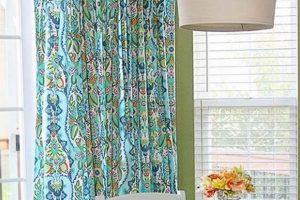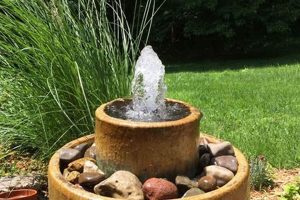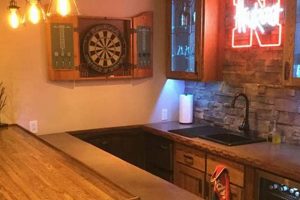The concept involves creating shade structures for outdoor living spaces using readily available materials and personal labor. These structures, attached to a building or freestanding, provide protection from sun and rain, enhancing the usability and comfort of patios. Examples range from simple fabric sails stretched between posts to more complex, framed structures covered with wood, metal, or synthetic materials.
Implementing such projects yields several advantages, including cost savings compared to professional installation, customization to specific aesthetic preferences and spatial requirements, and the satisfaction of crafting a functional outdoor feature. Historically, homeowners have sought ways to extend living spaces and improve outdoor comfort, leading to a variety of innovative and adaptable shading solutions.
The subsequent discussion will explore various approaches to shading patios. It will encompass material selection, design considerations, construction techniques, and relevant safety precautions, offering guidance for successfully implementing a customized solution.
Essential Considerations for Patio Shade Construction
Successful creation of a personalized patio covering necessitates careful planning and execution. Prioritizing structural integrity and material suitability is paramount.
Tip 1: Prioritize Structural Integrity: Before commencing construction, evaluate the existing structure to which the awning will be attached. Ensure it can bear the added weight and wind load. If freestanding, a robust foundation is crucial to prevent collapse or shifting.
Tip 2: Select Weather-Resistant Materials: Opt for materials that can withstand exposure to sun, rain, and wind. Treated lumber, galvanized steel, and UV-resistant fabrics are suitable choices, minimizing deterioration and extending the lifespan of the structure.
Tip 3: Account for Sun Angle and Orientation: Analyze the sun’s path throughout the day and year to determine the optimal angle and positioning for the covering. This will maximize shade during peak sunlight hours and minimize unwanted glare.
Tip 4: Ensure Proper Drainage: Design the awning with a slight slope to facilitate water runoff, preventing pooling and potential damage to the structure and surrounding area. Gutters and downspouts can further enhance drainage in regions with heavy rainfall.
Tip 5: Obtain Necessary Permits: Before beginning construction, verify local building codes and obtain any required permits. Failure to do so could result in fines or mandatory removal of the structure.
Tip 6: Secure Fasteners and Connections: Employ high-quality fasteners and connection methods to ensure the awning’s stability and resistance to strong winds. Properly tightened bolts, screws, and anchors are essential for preventing structural failure.
Tip 7: Consider Fabric Tension and Support: When utilizing fabric as a covering material, ensure adequate tension and support to prevent sagging and tearing. Properly spaced support cables or frames are crucial for maintaining fabric integrity.
Adhering to these guidelines enhances the safety, durability, and functionality of the patio shading solution, creating a comfortable and enjoyable outdoor living space.
The subsequent sections will delve into specific design ideas and material options, providing further insights for realizing a successful outdoor shade structure.
1. Material Selection
Material selection is a cornerstone of effective patio shading construction. The choice of materials directly impacts the structure’s durability, longevity, and overall aesthetic. Using substandard materials inevitably leads to premature failure, increased maintenance, and potential safety hazards. For instance, employing untreated lumber in a humid climate will result in rot and decay, compromising the structure’s integrity and necessitating costly repairs. Conversely, selecting durable, weather-resistant options such as treated lumber, aluminum, or high-density polyethylene (HDPE) fabric extends the structure’s lifespan and minimizes upkeep.
Different materials offer varying degrees of shade, weather protection, and aesthetic appeal. Solid wood or metal roofing provides complete protection from sun and rain but can block natural light. Fabric sails offer partial shade and airflow but may require more frequent replacement. Polycarbonate panels allow diffused light while offering rain protection, but they can be expensive and challenging to install. Cost considerations are also integral. Recycled or repurposed materials offer budget-friendly options, but their durability and aesthetic appeal may be limited compared to commercially manufactured alternatives. A practical example is using reclaimed wood pallets to create a rustic, cost-effective awning frame, balancing environmental consciousness with structural requirements.
In summary, careful consideration of material selection is paramount for a successful patio shading project. Factors like climate, budget, aesthetic preferences, and structural requirements influence material choices, ultimately determining the awning’s performance and longevity. Ignoring this critical aspect results in compromises in durability, functionality, and overall satisfaction with the finished structure. Prioritizing appropriate material selection ensures a lasting and aesthetically pleasing outdoor living space.
2. Structural Design
Structural design is paramount in the creation of any successful outdoor shading solution. It dictates the awning’s stability, load-bearing capacity, and overall resistance to environmental factors. Inadequate structural design can lead to collapse, injury, and property damage. Understanding fundamental engineering principles and material properties is therefore essential before undertaking construction.
- Load Calculations and Support Systems
Load calculations determine the amount of weight the awning must support, including its own weight, snow accumulation, and wind pressure. This informs the selection of appropriate support systems, such as posts, beams, and rafters. For example, a large awning in a region with heavy snowfall necessitates robust support structures capable of withstanding significant vertical loads. Failure to accurately calculate and accommodate these loads compromises structural integrity.
- Material Strength and Span Considerations
The strength of the materials used in construction dictates the maximum span between support points. Steel possesses greater tensile strength than wood, allowing for longer spans with fewer supports. However, steel is also more susceptible to corrosion if not properly treated. Careful consideration of material properties and span requirements optimizes structural efficiency and minimizes material costs. An example is using engineered lumber,
like laminated veneer lumber (LVL), which offers consistent strength properties and allows for longer spans compared to standard dimensional lumber. - Wind Resistance and Anchorage
Wind can exert significant force on awnings, especially those with large surface areas. Proper anchorage to the supporting structure or ground is crucial to prevent uplift or overturning. Design elements like open lattice structures or strategically placed vents can reduce wind resistance. An example is employing hurricane ties to securely fasten rafters to the supporting beam, enhancing the awning’s resistance to high winds.
- Drainage and Slope Considerations
Incorporating a slight slope into the awning’s design facilitates water runoff, preventing ponding and potential damage to the structure and surrounding area. Adequate drainage is particularly important in regions with heavy rainfall. A simple example is angling the awning surface a few degrees to direct water away from the patio and foundation, preventing water damage and ice accumulation.
These facets of structural design are not mutually exclusive; rather, they interact to create a safe, functional, and durable patio shading solution. Attention to these details is essential for ensuring a structure that can withstand environmental stressors and provide lasting enjoyment. Neglecting these aspects of structural design increases the risk of structural failure and costly repairs, undermining the overall success of the shading solution.
3. Installation Methods
The process of attaching a shade structure is as critical as the design and material selection. The method of installation determines the awning’s stability, longevity, and ability to withstand environmental stressors. Inadequate installation techniques compromise structural integrity, leading to premature failure, potential injury, and financial losses.
- Anchoring to Existing Structures
Securing the awning to a building necessitates the use of appropriate fasteners and anchoring techniques. The type of siding, wall material, and structural framing dictates the selection of anchors. For example, attaching an awning to brick requires masonry anchors, while attaching to wood siding requires lag screws or bolts. Failure to use the correct anchors results in a weak connection, potentially causing the awning to detach during strong winds. Proper sealing around the attachment points prevents water intrusion and damage to the building envelope.
- Foundation Construction for Freestanding Structures
For awnings not attached to a building, a stable foundation is essential. Concrete footings or piers provide a solid base for the support posts. The size and depth of the footings depend on soil conditions and the awning’s dimensions. In regions with frost heave, footings must extend below the frost line to prevent movement. Incorrect foundation construction leads to settling, tilting, or even collapse of the awning. Employing proper drainage around the foundation minimizes water accumulation and potential erosion.
- Fabric Attachment Techniques
Attaching fabric to the awning frame requires specialized techniques to ensure proper tension and prevent tearing. Grommets, webbing, and reinforced seams distribute stress and prevent fabric failure. The method of attachment varies depending on the fabric type and frame design. For instance, using a keder rail system allows for easy installation and removal of fabric panels. Improper fabric attachment leads to sagging, flapping, and premature wear.
- Ensuring Proper Slope and Drainage
Regardless of the awning design, incorporating a slight slope facilitates water runoff. This prevents water from pooling on the surface, which can damage the structure and create a breeding ground for mosquitoes. The slope can be achieved by adjusting the height of the support posts or rafters. Gutters and downspouts further enhance drainage. Failure to provide adequate slope and drainage leads to water damage, ice accumulation, and increased structural stress.
Selecting and implementing the correct installation methods is crucial for the success of any patio shading project. The approach directly impacts the awning’s stability, longevity, and ability to provide reliable shelter from the elements. A well-designed awning, when poorly installed, will invariably fail to meet its intended purpose, wasting time, resources, and potentially posing a safety risk. Therefore, careful consideration of the installation process is essential for achieving a functional, durable, and aesthetically pleasing outdoor living space.
4. Sun Path Analysis
Effective implementation of “diy patio awning ideas” necessitates a thorough understanding of solar trajectories. Accurate “Sun Path Analysis” is not merely beneficial, but foundational for optimizing shade coverage, regulating temperature, and maximizing the usability of outdoor spaces throughout the year.
- Determining Optimal Awning Placement
Solar trajectory analysis identifies periods of peak sunlight exposure, enabling precise placement of shading structures. For instance, a south-facing patio may require a deeper awning or strategically placed vertical screens to mitigate intense summer sun. Conversely, an east-facing patio might benefit from a retractable awning to allow morning sun during cooler months. Failure to account for these variables results in suboptimal shading and discomfort.
- Calculating Shade Coverage Area
The extent of shade cast by an awning varies significantly based on its dimensions and the sun’s angle. Solar analysis allows for the accurate calculation of shade coverage throughout the day and across seasons. This ensures that the desired area remains shaded during peak usage times, preventing glare and reducing heat gain. This process involves projecting the sun’s rays onto a horizontal plane, revealing the shadow’s shape and movement over time.
- Selecting Appropriate Awning Materials
The intensity of sunlight exposure directly influences the choice of materials for the awning. Areas with high solar irradiance require UV-resistant fabrics or materials with high reflectance to prevent fading, degradation, and excessive heat absorption. For example, dark-colored fabrics absorb more heat, potentially increasing the ambient temperature beneath the awning. Solar analysis informs the selection of materials that mitigate these effects and maintain a comfortable environment.
- Optimizing Awning Orientation and Angle
The orientation and angle of the awning significantly impact its shading effectiveness. A fixed awning with a steep angle provides optimal shade during summer but may block desirable sunlight during winter. A retractable awning allows for adjusting shade coverage based on seasonal variations. Sun path analysis enables informed decisions regarding awning orientation and angle, maximizing solar control throughout the year and enhancing the patio’s usability.
In conclusion, “Sun Path Analysis” provides the essential data for realizing the full potential of “diy patio awning ideas”. It ensures that shading structures are strategically placed, properly sized, and constructed from appropriate materials, creating a comfo
rtable and functional outdoor living space that responds to seasonal changes and minimizes undesirable solar effects.
5. Weather Resistance
The connection between “Weather Resistance” and “diy patio awning ideas” is one of critical interdependence. A patio awning’s fundamental purposeproviding shelter and extending outdoor living spaceis directly contingent upon its ability to withstand environmental stressors. Absent adequate resistance to weather, a shading structure is rendered ineffective, prone to damage, and potentially hazardous. This relationship dictates that material selection, structural design, and installation techniques must prioritize longevity and protection against the elements. For example, a fabric awning constructed from non-UV-resistant material will quickly degrade and tear under prolonged sun exposure, negating its intended function and requiring premature replacement. Similarly, a wooden frame not properly treated against moisture will succumb to rot, compromising its structural integrity and posing a safety risk.
The practical significance of understanding this connection manifests in multiple facets of awning construction. It informs the selection of durable, weather-resistant materials such as treated lumber, galvanized steel, or acrylic fabrics engineered to withstand sun, rain, wind, and temperature fluctuations. Proper weatherproofing also necessitates meticulous attention to detail during installation. Sealing joints and seams prevents water intrusion, while appropriate anchoring methods secure the structure against high winds. Furthermore, the design must incorporate adequate drainage to prevent water accumulation and reduce the risk of ice damage. Ignoring any of these factors compromises the awning’s overall resilience and reduces its lifespan.
In summary, “Weather Resistance” is not merely an ancillary attribute of “diy patio awning ideas” but a core requirement for its functional success and long-term value. Constructing a weather-resistant awning necessitates a holistic approach encompassing material selection, design considerations, and installation practices. While challenges such as fluctuating weather patterns and material costs may arise, prioritizing weather resistance remains essential for creating a durable, safe, and enjoyable outdoor living space. This understanding directly connects to the broader theme of sustainable and responsible construction practices, emphasizing the importance of building structures that endure environmental pressures and minimize the need for frequent repairs or replacements.
6. Cost Efficiency
The pursuit of economical solutions constitutes a primary driver behind engaging in do-it-yourself patio awning projects. The alternative professional installation frequently entails significant expenditures on labor, materials, and overhead costs, rendering it financially prohibitive for many homeowners. By undertaking the project independently, individuals can substantially reduce expenses through direct material procurement, utilization of existing tools, and elimination of contractor fees. This allows for the creation of functional outdoor shade structures within limited budgetary constraints. For instance, a homeowner might repurpose salvaged lumber or utilize discounted fabric remnants to construct a simple awning frame and covering, drastically lowering the overall project cost compared to purchasing a prefabricated system.
However, the emphasis on cost-effectiveness should not eclipse considerations of quality and durability. The selection of substandard materials or the implementation of inadequate construction techniques, while initially minimizing costs, can ultimately lead to premature failure and necessitate expensive repairs or replacements. A balanced approach involves sourcing affordable yet reliable materials, carefully planning the design to optimize material usage, and employing sound construction practices to ensure structural integrity. An example would be opting for pressure-treated lumber over untreated lumber, even if the former is slightly more expensive, to prevent rot and extend the awning’s lifespan, thereby reducing long-term maintenance costs. Furthermore, leveraging online resources for free design plans and tutorials can minimize reliance on costly professional design services.
In summary, the intersection of “Cost Efficiency” and “diy patio awning ideas” represents a trade-off between initial investment and long-term value. While the allure of minimizing upfront expenses is understandable, a prudent approach entails prioritizing durability and structural soundness to avoid future financial burdens. By strategically selecting materials, carefully planning the design, and employing proper construction techniques, individuals can achieve a harmonious balance between cost-effectiveness and lasting quality, resulting in a functional and aesthetically pleasing patio awning that enhances outdoor living without exceeding budgetary limitations. This approach aligns with the principles of resourcefulness and responsible home improvement, maximizing the return on investment and fostering a sense of self-sufficiency.
7. Permit Requirements
The nexus between “Permit Requirements” and “diy patio awning ideas” represents a critical aspect often overlooked in the enthusiasm of home improvement projects. Construction or alteration of structures attached to or adjacent to a dwelling frequently falls under the purview of local building codes and zoning regulations. The absence of proper permitting can lead to significant repercussions, including fines, mandatory removal of the unpermitted structure, and legal disputes with neighbors or local authorities. The causal relationship is direct: failure to adhere to “Permit Requirements” results in potential legal and financial liabilities. The importance of “Permit Requirements” as a component of “diy patio awning ideas” stems from its role in ensuring structural safety, adherence to zoning laws, and protection of property values within a community. A real-life example involves a homeowner who constructs a patio awning that violates setback requirements, subsequently facing legal action from neighbors and the municipality, ultimately incurring significant expenses to rectify the violation. The practical significance of understanding “Permit Requirements” lies in mitigating these risks and ensuring compliance with applicable regulations.
Further analysis reveals that “Permit Requirements” vary substantially depending on location, the awning’s size, and its method of attachment. Many municipalities require permits for structures exceeding a certain square footage or those permanently affixed to the building. The permitting process typically involves submitting detailed plans, obtaining necessary inspections, and paying associated fees. Some jurisdictions may have specific restrictions regarding awning materials, height limitations, or aesthetic requirements to maintain neighborhood consistency. For instance, a homeowner intending to build a large, enclosed patio awning might need to provide structural engineering calculations to demonstrate its ability to withstand wind and snow loads. Others may face limitations on the awning’s color or material to align with neighborhood architectural guideline
s. Neglecting to investigate and comply with these local regulations can result in project delays, costly modifications, or forced demolition.
In conclusion, acknowledging and fulfilling “Permit Requirements” constitutes an indispensable step in the “diy patio awning ideas” process. While the application procedures and associated costs might appear cumbersome, they serve to protect both the homeowner and the community by ensuring structural safety, code compliance, and adherence to zoning regulations. Challenges may arise in navigating complex bureaucratic processes or interpreting ambiguous regulations, but these can be mitigated by proactive engagement with local building departments and thorough research. This understanding contributes to the broader theme of responsible homeownership, emphasizing the importance of balancing personal creativity with legal obligations to create sustainable and compliant outdoor living spaces.
Frequently Asked Questions Regarding DIY Patio Awning Projects
This section addresses common inquiries concerning the planning, design, and execution of self-constructed patio shade structures.
Question 1: Are building permits invariably required for patio awning construction?
Building permit requirements vary significantly based on local regulations, structure size, and attachment method. Investigation of local building codes is essential prior to commencing any construction activity. Failure to obtain necessary permits may result in fines or mandatory removal of the structure.
Question 2: What materials are most suitable for ensuring weather resistance in a patio awning?
The selection of weather-resistant materials is paramount for awning longevity. Treated lumber, galvanized steel, and UV-resistant fabrics are commonly employed. The specific choice depends on budgetary constraints, aesthetic preferences, and the severity of the local climate.
Question 3: How does sun path analysis contribute to effective patio awning design?
Sun path analysis allows for optimized awning placement to maximize shade coverage during peak sunlight hours. This involves assessing the sun’s trajectory throughout the year and tailoring the awning’s orientation and dimensions accordingly.
Question 4: What structural considerations are essential for a stable and safe patio awning?
Structural integrity is non-negotiable. Proper load calculations, adequate support systems, and robust anchorage are critical for ensuring stability and resistance to wind and snow loads. Professional consultation may be warranted for complex designs.
Question 5: How can costs be minimized while maintaining acceptable quality in a DIY patio awning project?
Cost-efficiency can be achieved through strategic material sourcing, repurposing of existing resources, and careful design planning to minimize waste. However, compromising structural integrity for the sake of cost savings is ill-advised.
Question 6: What are the key safety precautions to observe during patio awning construction?
Safety should be prioritized throughout the construction process. This includes wearing appropriate personal protective equipment, employing safe tool handling practices, and securing the work area to prevent accidents. If unfamiliar with construction techniques, seeking guidance from experienced individuals is prudent.
These frequently asked questions highlight the critical considerations involved in DIY patio awning projects. Thorough planning, adherence to safety guidelines, and compliance with local regulations are essential for successful implementation.
The following section will provide a summary of the key takeaways from this discussion, further solidifying the fundamental principles of DIY patio awning construction.
Conclusion
The preceding discussion has detailed the multifaceted considerations inherent in “diy patio awning ideas”. From navigating permit requirements and optimizing sun path analysis to selecting appropriate materials and adhering to structural design principles, the successful implementation of such projects demands a comprehensive understanding of the underlying technical and regulatory aspects. The intent has been to provide a framework for informed decision-making, enabling individuals to approach these endeavors with prudence and diligence.
Creating a functional and aesthetically pleasing outdoor space through self-directed effort represents a worthwhile endeavor. However, such projects must be undertaken with a commitment to safety, compliance, and responsible construction practices. Prioritizing these elements ensures not only the longevity and utility of the finished structure but also contributes to the well-being of the community and the preservation of property values. Individuals are encouraged to apply the knowledge gained herein with careful deliberation and a focus on achieving enduring results.







